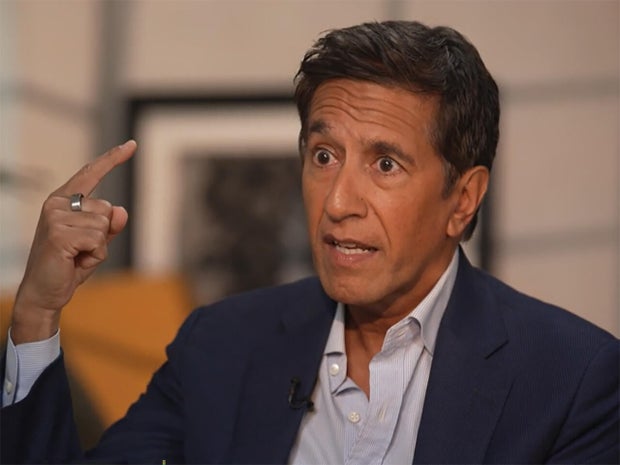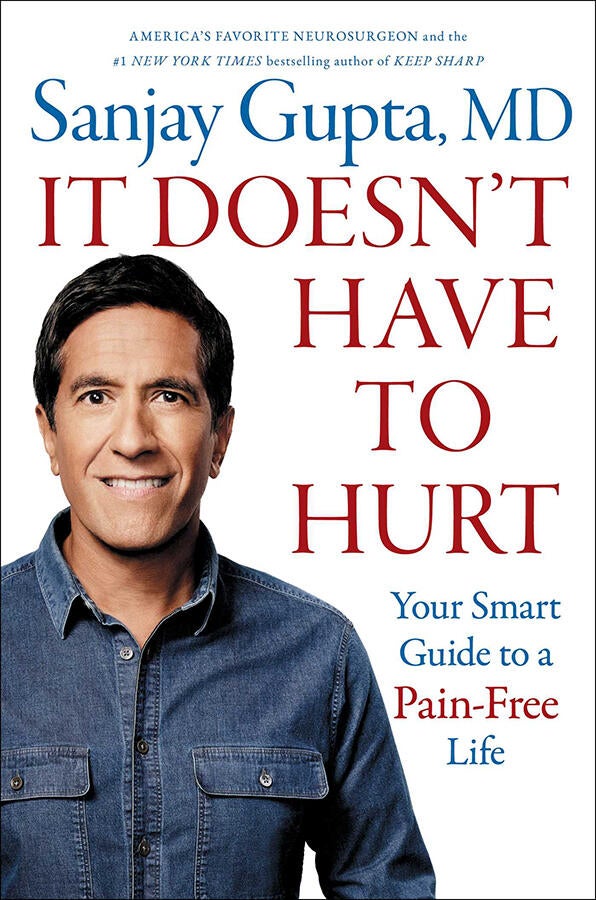
Ed Mowery, the founder and lead singer of a death metal band, suffered unfathomable pain for decades: "It was 24/7, 365," he said, likening it to "lightning bolt razor snakes in my legs and nerve pain in my arms.
"Have you ever had a really bad burn when you're cooking? Imagine that really bad burn, multiply it by, say, 20 to 30, and then apply it from the neck down. And on top of that burn was the lightning bolt razor snakes in my legs and the crazy nerve burn in my arms. So, it was several different kinds of pain at once."
It's a rare condition affecting 200,000 people in the U.S., called complex regional pain syndrome, or CRPS. But doctors could find no cause for it.
"There was nothing to point to and says, 'This is why it's hurting.' It was just a sort of unrelenting pain," said Dr. Sanjay Gupta, best known as chief medical correspondent at CNN. A neurosurgeon and author, his latest book, "It Doesn't Have to Hurt," explores the mystery of pain – mundane aches and pains, or excruciating pain like Mowery suffered.
A lot of Americans are hurting; the CDC says approximately 20% are in pain. And while writing the book, Gupta found one of them was his mother – 83-year-old Damyanti Gupta, who had a fall right outside her front door.
"I had osteoporosis," she said, "and I think one of my bones must have given up, I think, because I didn't trip over anything."
Imaging showed a compressed lumbar vertebra. But pain doesn't appear on X-rays and MRIs. "You know how they ask you, doctors tell me, 'From a scale of one to 10, what is your pain?' I would've said 100," Damyanti said. "You don't really realize 'til you have it. I never realized that pain can be that terrible. You don't want to even live anymore."
"I don't want to live anymore – coming from my mom, obviously it's really painful to hear," said Dr. Gupta. "But also this was someone who'd never complained about anything. So, you had a sense of just how significant an impact this was on her."
Spinal surgery successfully repaired the injured spine, and immediately Damyanti's pain went from 100 to about 3.
The surprising source of pain
As a brain surgeon, Gupta sees patients in pain every day, but he personally experienced serious pain when he was a kid who thought he could vault over a spiked fence. "I don't know what I was thinking," he said. "But I didn't make it. And this spike from the fence went right through the back of my skin on the side, and came right out the front. So, I was essentially pinned and impaled on top of this fence."
As the shock wore off, the future doctor – still on the fence – took note: "The pain started to come in waves. So it was there, felt like someone was sort of slapping my back, but then after a while it just didn't hurt that much anymore. And there was a couple of times when I had to reach back around and say, 'It's still there, right?' Even at the time, that struck me as a really surprising experience. Like, I had a hot poker thing going through my back, and yet I'm not feeling pain? Like, why would that be?"
Later, he learned the reason why. "It took years to sort of understand this," he said. "My body's endogenous opioid system – we have our own opioid system – it reacted, and it reacted in a big, big way. Because the body is just flooded with all these opioids and it improves my mood, it decreases my memory of the painful experience, and obviously it helps with the overall hurt.
"These are endorphins, and by the way, endorphins – endo, which means comes from your body, and phin, morphine—so it's like your body's own natural morphine," he said.
After years of suffering despite pain medication (including morphine), Ed Mowery joined a clinical trial at the University of California at San Francisco, which not only found the source of those "lightning bolt razor snakes," but would make headlines around the world.
The source of the pain, said Gupta, was "the brain. It's hard to conceptualize, I realize this. But Ed is sort of this daredevil guy. He had a lot of injuries over his life. He had had a knee operation, and it was after that knee operation that, for some reason, his brain had taken the experience of his knee surgery and started to memorize it, and got it a little bit wrong. So instead of saying, 'Hey, your knee hurts,' it just went into this hyper-drive. The best metaphor would be something known as 'phantom pain.' That's when someone loses a limb and then they still hurt, even though that limb doesn't even exist anymore. How can that happen? The brain. The brain is creating that pain. Why that's happening exactly, we're not sure."
"Shutting off" the pain
Mowery had volunteered for a study in deep brain stimulation and pain, and three rounds of brain surgery. "I had nodes sticking out of my head," Mowery said. "And I had 144 wires going to two computers. And I had a turban on my head. And I also had a lot more hair!"
Gupta said, "After weeks they were able to draw this link between Ed's pain and these changes in the brain. And what they found with Ed was not only could they start to predict that Ed was gonna have pain, they could quantify how bad that pain was likely to be, and they could even interrupt the pain by giving a little stimulation. So even before the pain would get to conscious awareness, the stimulator would go off and it would start to interrupt that pain cycle."
Gupta predicts Mowery's story is just the beginning: "What these doctors were able to do, they were essentially able to put these probes all over the brain and just leave these probes in sort of to listen to Ed's brain."
Even now, a computer can recognize his pain coming on – and shut it off.
It's been life-changing for Mowery, who spoke about the clinical trial at the National Institutes of Health: "The last two days of testing, the signal started working, and killing my pain," he said. "I was beside myself."
Though a small study, the implications for managing all sorts of pain are far-reaching. As Gupta explains, the brain is the source of every sensation of pain, from a paper cut, to a broken vertebra, to "razor snakes."
I asked Mowery, "Did you know when you signed up for this, what you were signing up for?"
"It's funny you ask that question, because when I first found out, I said, 'There's no way. I'm not doing three brain surgeries. You're not going into my brain. No way," Mowery said. "And then a year-and-a-half later, I was in so much pain, I just didn't care anymore."
"You seem very comfortable when you describe this as your brain," I said.
"It took me a while to wrap my brain around the fact that this is a brain disease," Mowery replied. "It took a long time for me to just say, oh, you know, this is actually all in my head. But it wasn't imaginary. It was real."
Today, Mowery is playing his music again, and looking forward to touring internationally with his band. "I never lost hope," he said, "because I knew something would come along to help me. And I think that's part of what got me through all this, was my attitude towards the whole thing."
READ AN EXCERPT: "It Doesn't Have to Hurt" by Dr. Sanjay Gupta
WEB EXCLUSIVE: Watch an extended interview with Dr. Sanjay Gupta (Video)
For more info:
Story produced by Kay Lim and Young Kim. Editor: Ed Givnish.
See also:












-3.png)



